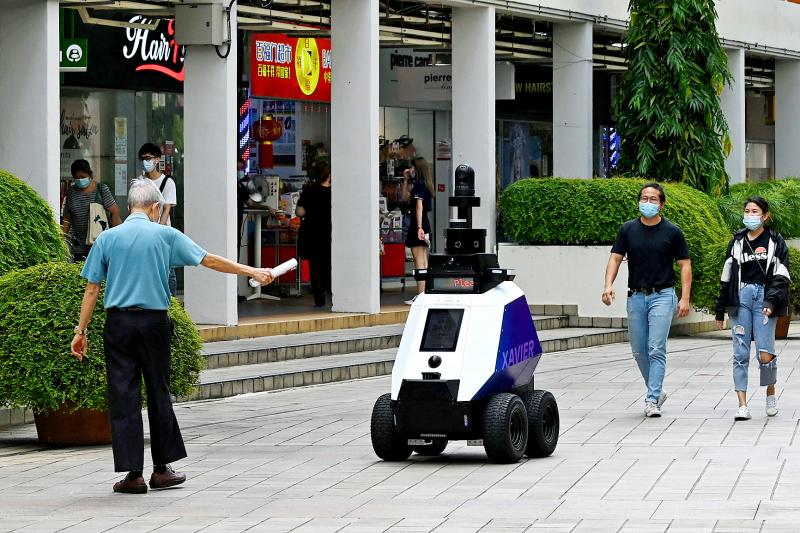Singapore has trialled patrol robots that blast warnings at people engaging in “undesirable social behavior,” adding to an arsenal of surveillance technology in the tightly controlled city-state that is fueling privacy concerns.
From vast numbers of closed-circuit television cameras to trials of lampposts kitted out with facial recognition technology, Singapore is seeing an explosion of tools to track its inhabitants.
Officials have long pushed a vision of a hyper-efficient, tech-driven “smart nation,” but activists say privacy is being sacrificed and people have little control over what happens to their data.

Photo: AFP
Singapore is frequently criticized for curbing civil liberties and people are accustomed to tight controls, but there is still growing unease about intrusive tech.
The government’s latest surveillance devices are robots on wheels, with seven cameras, that detect undesirable behavior. This includes smoking in prohibited areas, improperly parking bicycles and breaching COVID-19 social distancing rules.
During a recent patrol, one of the “Xavier” robots wove its way through a housing estate and stopped in front of a group of elderly residents watching a chess match.
“Please keep 1m distancing, please keep to five persons per group,” a robotic voice blared out, as a camera on top of the machine trained its gaze on them.
During a three-week trial last month, two robots were deployed to patrol the housing estate and a shopping center.
“It reminds me of Robocop,” said Frannie Teo, a 34-year-old research assistant, who was at the mall. “It brings to mind a “dystopian world of robots... I’m just a bit hesitant about that kind of concept.”
Digital rights activist Lee Yi-ting said the devices were the latest way Singaporeans are being watched.
“It all contributes to the sense people ... need to watch what they say and what they do in Singapore to a far greater extent than they would in other countries,” she said.
However, the government defended its use of robots, saying they were not being used to identify or take action against offenders during the trial, and were needed to address a labor crunch as the population ages.
“The workforce is actually shrinking,” said Ong Ka-hing, from the government agency that developed the Xavier robots, adding that they could help reduce the number of officers for foot patrols.
The island of about 5.5 million people has 90,000 police cameras, a number set to double by 2030, and facial recognition technology, which helps authorities pick out faces in a crowd, could be installed on lampposts across the city-state.
There was a rare public backlash this year when authorities admitted that COVID-19 contract-tracing data collected by an official system had been accessed by police. The government later passed legislation to limit its use.
However, critics say laws generally put few limitations on government surveillance, and Singaporeans have little control over what happens to the data collected.
“There are no privacy law constraints on what the government can or cannot do,” said Indulekshmi Rajeswari, a privacy lawyer from Singapore who is based in Germany.

Former Nicaraguan president Violeta Chamorro, who brought peace to Nicaragua after years of war and was the first woman elected president in the Americas, died on Saturday at the age of 95, her family said. Chamorro, who ruled the poor Central American country from 1990 to 1997, “died in peace, surrounded by the affection and love of her children,” said a statement issued by her four children. As president, Chamorro ended a civil war that had raged for much of the 1980s as US-backed rebels known as the “Contras” fought the leftist Sandinista government. That conflict made Nicaragua one of

COMPETITION: The US and Russia make up about 90 percent of the world stockpile and are adding new versions, while China’s nuclear force is steadily rising, SIPRI said Most of the world’s nuclear-armed states continued to modernize their arsenals last year, setting the stage for a new nuclear arms race, the Stockholm International Peace Research Institute (SIPRI) said yesterday. Nuclear powers including the US and Russia — which account for about 90 percent of the world’s stockpile — had spent time last year “upgrading existing weapons and adding newer versions,” researchers said. Since the end of the Cold War, old warheads have generally been dismantled quicker than new ones have been deployed, resulting in a decrease in the overall number of warheads. However, SIPRI said that the trend was likely

NUCLEAR WARNING: Elites are carelessly fomenting fear and tensions between nuclear powers, perhaps because they have access to shelters, Tulsi Gabbard said After a trip to Hiroshima, US Director of National Intelligence Tulsi Gabbard on Tuesday warned that “warmongers” were pushing the world to the brink of nuclear war. Gabbard did not specify her concerns. Gabbard posted on social media a video of grisly footage from the world’s first nuclear attack and of her staring reflectively at the Hiroshima Peace Memorial. On Aug. 6, 1945, the US obliterated Hiroshima, killing 140,000 people in the explosion and by the end of the year from the uranium bomb’s effects. Three days later, a US plane dropped a plutonium bomb on Nagasaki, leaving abut 74,000 people dead by the

Indian Prime Minister Narendra Modi is to visit Canada next week, his first since relations plummeted after the assassination of a Canadian Sikh separatist in Vancouver, triggering diplomatic expulsions and hitting trade. Analysts hope it is a step toward repairing ties that soured in 2023, after then-Canadian prime minister Justin Trudeau pointed the finger at New Delhi’s involvement in murdering Hardeep Singh Nijjar, claims India furiously denied. An invitation extended by new Canadian Prime Minister Mark Carney to Modi to attend the G7 leaders summit in Canada offers a chance to “reset” relations, former Indian diplomat Harsh Vardhan Shringla said. “This is a